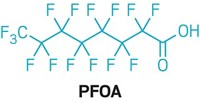Advertisement
Grab your lab coat. Let's get started
Welcome!
Welcome!
Create an account below to get 6 C&EN articles per month, receive newsletters and more - all free.
It seems this is your first time logging in online. Please enter the following information to continue.
As an ACS member you automatically get access to this site. All we need is few more details to create your reading experience.
Not you? Sign in with a different account.
Not you? Sign in with a different account.
ERROR 1
ERROR 1
ERROR 2
ERROR 2
ERROR 2
ERROR 2
ERROR 2
Password and Confirm password must match.
If you have an ACS member number, please enter it here so we can link this account to your membership. (optional)
ERROR 2
ACS values your privacy. By submitting your information, you are gaining access to C&EN and subscribing to our weekly newsletter. We use the information you provide to make your reading experience better, and we will never sell your data to third party members.
Environment
Perfluorinated compounds got increased scrutiny
Federal agencies and courts had their say on the environmentally long-lived substances
by Jessica Morrison , Marc S. Reisch
December 14, 2016
| A version of this story appeared in
Volume 94, Issue 49
Two perfluorinated compounds—perfluorooctanoic acid (PFOA) and perfluorooctane sulfonate (PFOS)—were the focus of U.S. federal regulation and a handful of lawsuits in 2016.
Though the major companies that make or use PFOA agreed in 2006 to phase out production, the chemicals persist in the environment because of the strength of their carbon-fluorine bonds. Once used in the manufacture of nonstick materials, such as 3M’s Scotchgard and DuPont’s Teflon, the perfluorinated substances have been linked to disease in humans.
After more than a decade of study, the Environmental Protection Agency in May issued a lifetime health advisory for PFOA and PFOS in drinking water. According to the agency’s new guidelines, utilities should notify consumers when the chemicals exceed 70 parts per trillion—individually or combined—in drinking water.
Environmental advocates, including environmental attorney Robert A. Bilott questioned EPA’s delay in setting a chronic exposure limit for drinking water. “That is something that could have been and should have been done 15 or 16 years ago,” Bilott says.
In response to a 2014 petition by environmental and public health groups linking perfluorinated chemicals to cancer and birth defects, the Food & Drug Administration this year banned five perfluoroalkyl substances from use in U.S. food packaging.
The environmental fallout over perfluorinated chemicals generated a variety of legal activities this year. In February, residents of Hoosick Falls, N.Y., sued Honeywell International and Saint-Gobain Performance Plastics for contaminating the village’s water supply. Both firms used PFOA to make stain-resistant fabrics.
In July, a jury ordered DuPont and its spin-off Chemours to pay $5.6 million to a testicular cancer victim who traced his illness to Chemours’s Parkersburg, W.Va., fluorochemical plant. The suit is one of 3,500 pending in federal court in Columbus, Ohio, by plaintiffs who live near the Parkersburg plant.
And in Alabama, one utility notified its customers that PFOA and PFOS levels exceeded guidelines for drinking water and then sued 3M and carpet makers in October for remediation costs. Years ago, the carpet makers used the perfluorinated substances in stain-resistant broadloom treatments.
C&EN's YEAR IN REVIEW
Top Headlines of 2016
- Hawaii explosion cost a researcher an arm
- TSCA reform crossed the finish line
- U.S. elected Trump as president
- The periodic table got four new elements
- Post Dow-DuPont, chemical deal-making waned as 2016 advanced
- Labs made advances in Zika research
- Four ag giants to rule them all
- 2016 Nobel Prize in Chemistry at a glance
- Brexit bomb exploded
- Focus returned to Iran's chemical industry
- Overtime pay limit doubles under Obama administration
- The CRISPR craze continued
- Perfluorinated compounds got increased scrutiny
- From the lab to the market
- Paris Agreement to curb climate change took off
- World chemical production at a glance
- Flint's water woes lingered
- As China's economy slowed, chemical makers adjusted
- Mostafa A. El-Sayed won the 2016 Priestley Medal
- ACS members on average fared better than young graduates in employment surveys
- ACS invests internationally
- Spun-off firms found their footing in 2016
- Remembering the Nobel laureates we lost in 2016
- ACS proposed chemistry preprint server
- Berkeley College of Chemistry avoided reorganization
- Fight against opioid epidemic continued in 2016
- Noble gas shortages averted, for now
- The shale gas boom by the numbers
- Crop protection products in the crosshairs
- ACS launched new journals
- Website search terms of the year
- Biobased materials hit the big time
- No better deal emerged for Mossville, La.
- U.S. prepares for national food labeling standard
Top Research of 2016
- Mini factory made drugs on demand
- World's first PET-munching microbe discovered
- Liquid metals went to work
- Methylene activation reached new heights
- Biological structures of the year
- Wearable sensors were 'the' fashion accessories of 2016
- Scientists beefed up the antibiotic arsenal
- An enzymatic route to carbon-silicon bonds
- Single-atom catalysts gained a toehold
Revisiting Research of 2006






Join the conversation
Contact the reporter
Submit a Letter to the Editor for publication
Engage with us on Twitter